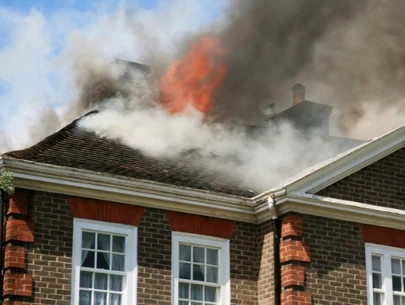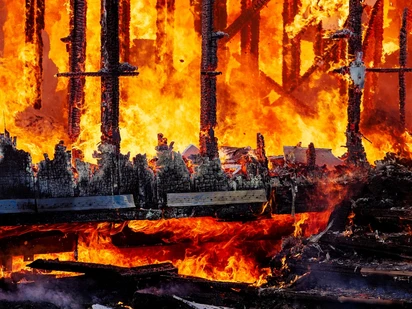Fire is the most common of all hazards. Every year, fires cause thousands of deaths and injuries and billions of dollars in property damage.

A fire can engulf a structure in a matter of minutes. During a fire, early warning from a working smoke alarm plus a fire escape plan that has been practiced regularly can save lives. Due to modern building materials and open space configurations, the severity of home fires is increasing. It's crucial that people understand the dangers of smoke and are prepared to leave their homes immediately in the event of fire.
For additional information about fire safety, escape planning and more, visit the U.S. Fire Administration website.
What to do before, during, and after a Fire
Prepare for a fire
Plan and Practice
Develop and practice an escape plan. Make sure all family members know what to do in a fire.
- Draw a floor plan with at least two ways of escaping every room. Choose a safe meeting place outside the house.
- Practice alerting other household members. It is a good idea to keep a bell and a flashlight in each bedroom for this purpose.
- Practice evacuating the building blindfolded. In a real fire situation, the amount of smoke generated by a fire will most likely make it impossible to see.
- Practice staying low to the ground when escaping.
- Feel all doors before opening them. If the door is hot, get out another way.
- Learn to stop, drop to the ground, and roll if clothes catch fire.
- Post emergency numbers near telephones.However, be aware that if a fire threatens your home, you should not place the call to your emergency services from inside the home. It is better to get out first and place the call from somewhere else.
- Purchase collapsible ladders at hardware stores and practice using them.
- Install A-B-C type fire extinguishers in the home and teach family members how to use them.
- Do not store combustible materials in closed areas or near a heat source.
Smoke Detectors
- Install smoke detectors. Check them once a month and change the batteries at least once a year.
- Smoke detectors more than double the chance of surviving a fire.
- Smoke detectors sense abnormal amounts of smoke or invisible combustion gases in the air. They can detect both smoldering and burning fires.
- At least one smoke detector should be installed on every level of a structure.
- Purchase smoke detectors labeled by the Underwriter’s Laboratories (UL) or Factory Mutual (FM).
Check electrical wiring
- Replace wiring if frayed or cracked.
- Make sure wiring is not under rugs, over nails, or in high traffic areas. Do not overload outlets or extension cords.
- Outlets should have cover plates and no exposed wiring.
- Only purchase appliances and electrical devices that have a label indicating that they have been inspected by a testing laboratory such as Underwriter’s Laboratories (UL) or Factory Mutual (FM).
Heating Devices
- Heating devices such as portable heaters, wood stoves, and fireplaces demand safe operation. Use portable heaters in well-ventilated rooms only.
- Refuel kerosene heaters outdoors only.
- Have chimneys and wood stoves cleaned annually.
- Buy only approved heaters and follow the manufacturers’ directions.
Be safe when cooking
- Keep the stove area clean and clear of combustibles such as bags, boxes, and other appliances.
- If a fire starts, put a lid over the burning pan or use a fire extinguisher. Be careful. Moving the pan can cause the fire to spread.
- Never pour water on grease fires.
The U.S. Fire Administration has more information on fire safety and firefighting.
During a fire
- Get out as quickly and as safely as possible.
- Use the stairs to escape. Do not use an elevator.
- When evacuating, stay low to the ground.
- If possible, cover your mouth with a cloth to avoid inhaling smoke and gases.
- Close the doors in each room after escaping to delay the spread of the fire.
- If you are in a room with a closed door:
- If smoke is pouring in around the bottom of the door or it feels hot, keep the door closed.
- Open a window to escape or for fresh air while awaiting rescue.
- If there is no smoke at the bottom or top and the door is not hot, then open the door slowly.
- If there is too much smoke or fire in the hall, slam the door shut.
- Call the fire department or 911 from a location outside the house.
After you escape fire
- Give first aid where appropriate.
- Seriously injured or burned victims should be transported to professional medical help immediately.
- Stay out of damaged buildings. Return home only when local fire authorities say it is safe.
- Look for structural damage.
- Discard food that has been exposed to heat, smoke, or soot.
- Contact your insurance agent.
- Don’t discard damaged goods until after an inventory has been taken. Save receipts for money relating to fire loss.
Iowa Disaster History - Merle Hay Mall Younkers Fire of 1978
1978 Merle Hay Mall Younkers Fire
10
fatalities
$20M
in damage

1978 Merle Hay Mall Younkers Fire
The original Younkers store at Merle Hay Mall was destroyed by a fire that broke out about 9:30 AM on November 5, 1978. The fire caused an estimated $20 million in damage, and ten store employees lost their lives.
